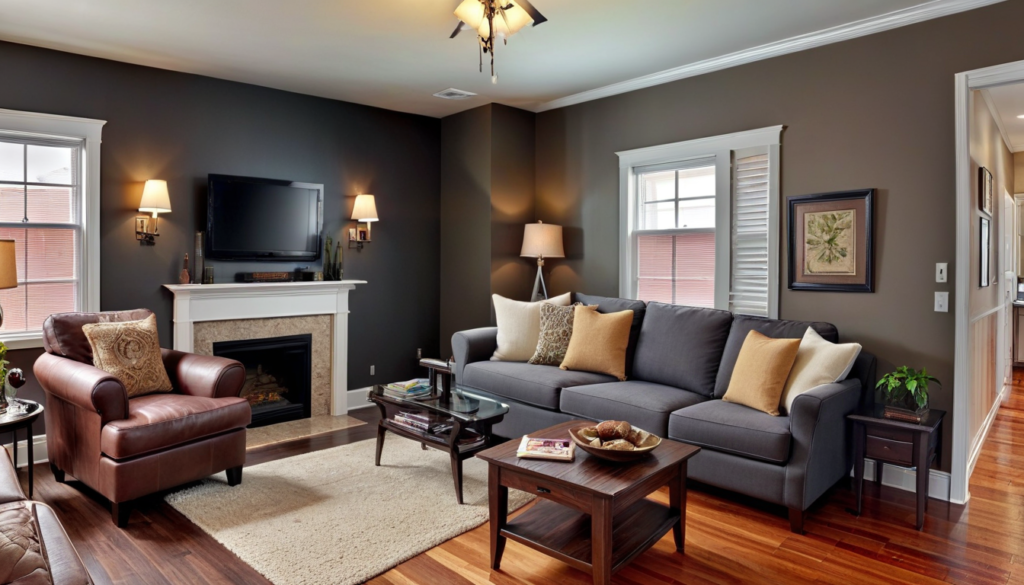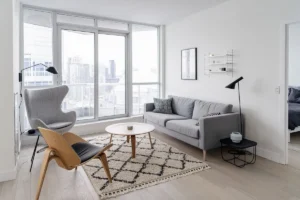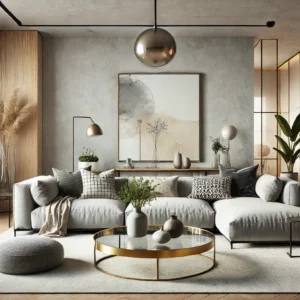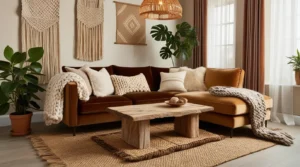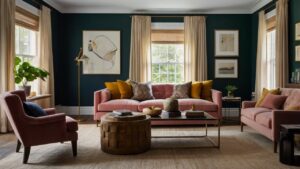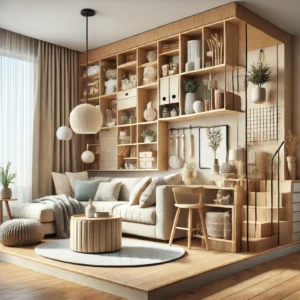Creating a functional and beautiful living room in a limited space can feel challenging, but with the right design strategies, even the smallest lounge can feel open, airy, and inviting. This comprehensive guide offers practical solutions—from color choices to clever furniture selection—that will help you maximize your space while maintaining a stylish aesthetic.
Table of Contents
- Color Choices: Setting the Tone for Openness
- Furniture Selection: Think Low and Functional
- Layout and Space Management: Create Flow and Openness
- Lighting: Brighten Up Your Space
- Decorative Elements: Add Depth and Texture
- Visual Tricks: Clever Solutions for Spaciousness
- Smart Storage Solutions: Keeping Clutter at Bay
- Incorporating Nature: Bringing the Outdoors In
- Technological Integration: Minimalist Tech for Modern Living
- Seasonal Adjustments: Adapting Your Space Year-Round
Color Choices: Setting the Tone for Openness
Use Light Colors to Reflect Light
Light shades, like white, cream, soft grays, or pastels, bounce natural and artificial light around the room, creating a sense of airiness and making the space appear larger. Painting the ceiling in a lighter hue also enhances height perception.
Pro Tip: Avoid dark colors on large surfaces, as they can make a small space feel more enclosed.
Coordinate Wall and Furniture Colors for a Seamless Look
Matching your key furniture pieces—like sofas and cabinets—to the wall color creates a unified design. This reduces visual breaks and enhances the room’s continuity, contributing to an open, spacious feel.
Experiment with Monochromatic Schemes
A monochromatic color scheme using different shades and tones of the same color can create depth while maintaining a cohesive and spacious look. This approach allows for subtle variations that add interest without overwhelming the space.
Furniture Selection: Think Low and Functional

Choose Low-Profile or Raised-Leg Furniture
Low-to-the-ground furniture gives the illusion of higher ceilings. Alternatively, raised-leg furniture reveals more visible floor space, helping the room feel less cluttered.
Pro Tip: Opt for sleek, modern furniture that doesn’t overpower the space.
Use Multi-Functional Furniture to Limit Clutter
Storage ottomans, foldable tables, or sofas with hidden storage can help maintain order. Fewer visible items mean less visual clutter, which instantly makes the space feel more expansive.
Invest in Slim and Streamlined Pieces
Choose furniture with clean lines and slim profiles. A slender sofa or armchair can provide comfortable seating without dominating the room. Consider glass or acrylic coffee tables that allow light to pass through, creating a sense of openness.
Layout and Space Management: Create Flow and Openness
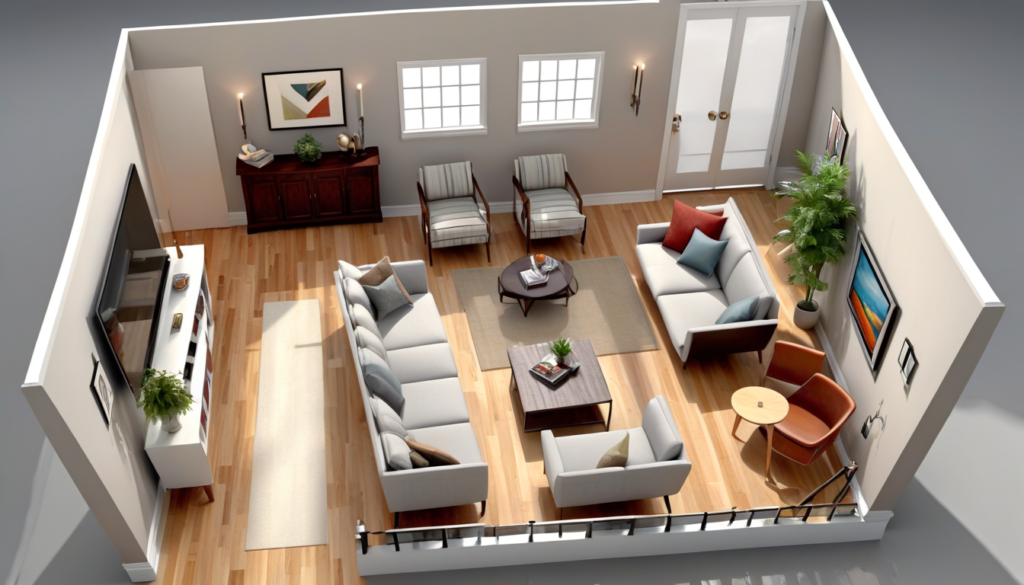
Arrange Furniture Thoughtfully
Rather than pushing furniture against the walls, consider placing seating arrangements slightly away from the edges. This breathing space prevents the room from feeling boxed in.
Pro Tip: Group furniture pieces to create a cozy but open seating area.
Keep Pathways Clear for Better Flow
Make sure walkways are unobstructed by furniture. Clear paths allow for smooth movement and improve visibility across the room, making it feel larger.
Create Zones Within the Space
Even in a small living room, you can create distinct areas for different activities. Use area rugs or furniture placement to define spaces for conversation, reading, or media viewing. This zoning technique can make the room feel more organized and purposeful.
Lighting: Brighten Up Your Space
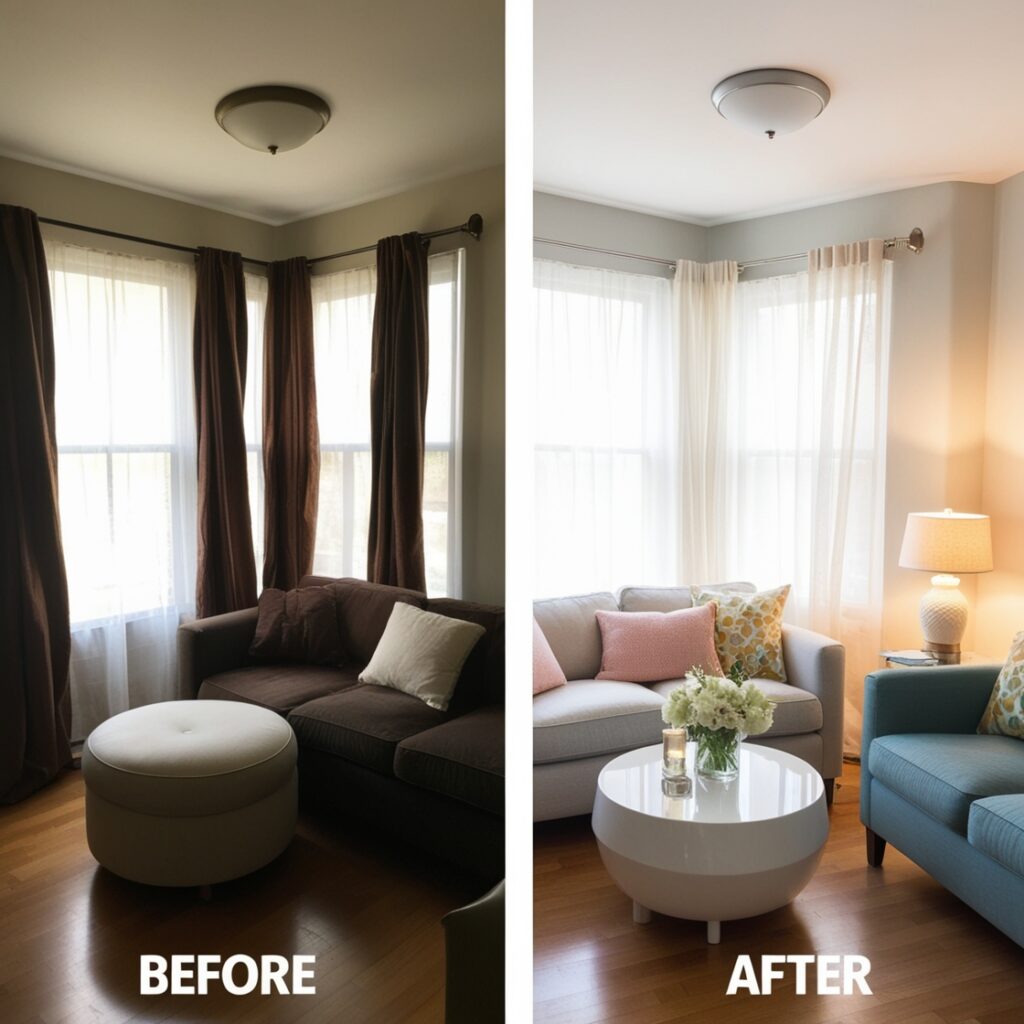
Maximize Natural Light with Sheer Curtains
Choose lightweight curtains or blinds that can be pulled fully aside to let in natural light. Extending curtain rods beyond the window frame also creates the illusion of wider windows.
Layer Your Lighting for Depth and Warmth
Incorporate multiple lighting sources at different levels—such as pendant lights, floor lamps, and table lamps—to add dimension and create a warm, welcoming atmosphere. Dimmer switches let you adjust lighting to suit any occasion.
Utilize Task Lighting
Incorporate focused lighting for specific activities, such as reading lamps near seating areas or under-cabinet lighting in built-in shelving units. This targeted illumination not only serves a practical purpose but also adds depth to the room’s lighting scheme.
Decorative Elements: Add Depth and Texture

Use Mirrors to Reflect Light and Expand Space
Mirrors placed opposite windows or next to light sources can reflect natural light throughout the room, giving it depth and making it feel larger.
Pro Tip: Opt for one large mirror or a statement mirror rather than several small ones to reduce visual clutter.
Incorporate Soft Textures for Warmth
Use textured pillows, cozy rugs, and plush throws to add warmth and personality without overwhelming the room. Mixing textures creates an inviting atmosphere while maintaining a minimalist look.
Choose Art Wisely
Select artwork that adds depth to the room. Large-scale pieces or gallery walls with a cohesive theme can create a sense of expansiveness. Consider pieces with perspective or landscapes that give the illusion of looking into another space.
Visual Tricks
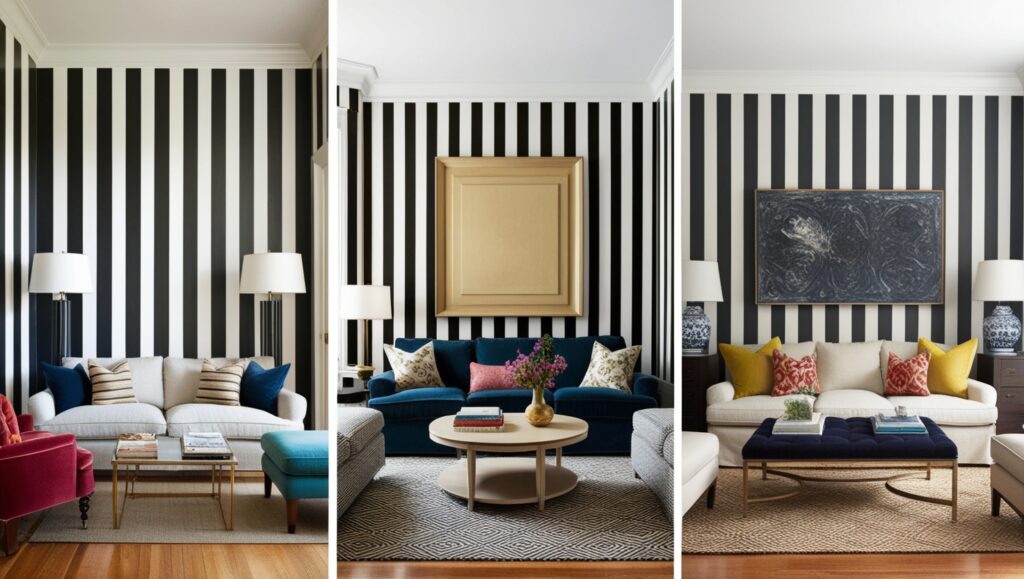
Use Patterns Strategically
Vertical stripes on walls or curtains draw the eye upward, making ceilings appear taller, while horizontal stripes on rugs can make narrow rooms seem wider.
Create a Focal Point to Minimize Visual Noise
Rather than cluttering walls with several small artworks, select one large statement piece—such as a painting or decorative mirror. This helps to anchor the room and maintain a sense of spaciousness.
Employ the Rule of Thirds
When arranging furniture and decor, use the rule of thirds to create balance and visual interest. Divide your room into a 3×3 grid and place key elements along these lines or at their intersections for a harmonious layout.
Smart Storage Solutions
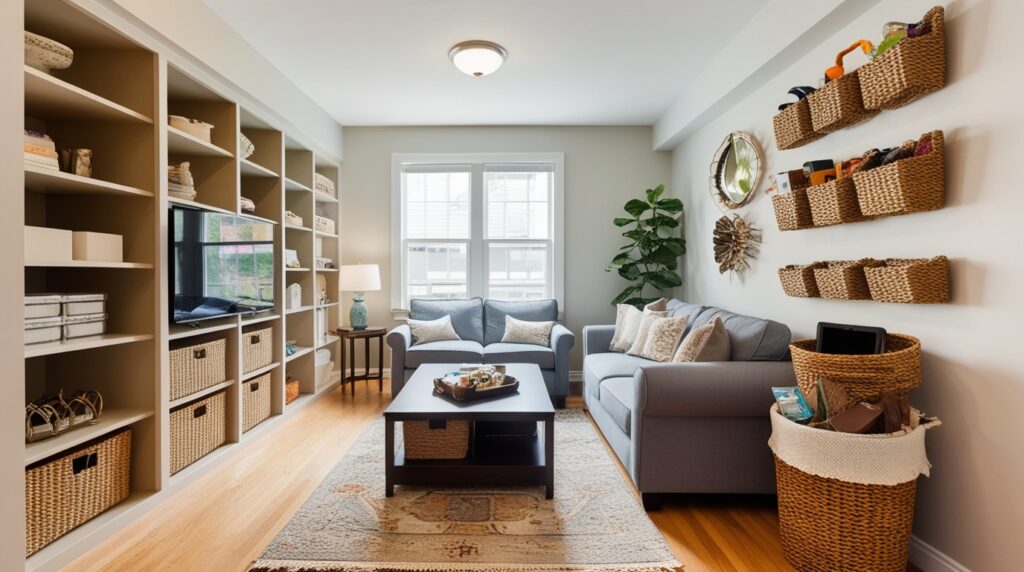
Utilize Vertical Space
Make use of your walls by installing floating shelves or floor-to-ceiling bookcases. This not only provides additional storage but also draws the eye upward, creating the illusion of higher ceilings.
Invest in Dual-Purpose Furniture
Choose furniture pieces that offer hidden storage, such as coffee tables with drawers, storage benches, or ottomans with removable tops. These items help maintain a clutter-free environment without sacrificing style or comfort.
Organize with Style
Use decorative baskets, boxes, or trays to corral smaller items. These organizers can be both functional and aesthetically pleasing, contributing to the room’s decor while keeping surfaces tidy.
Incorporating Nature: Bringing the Outdoors In
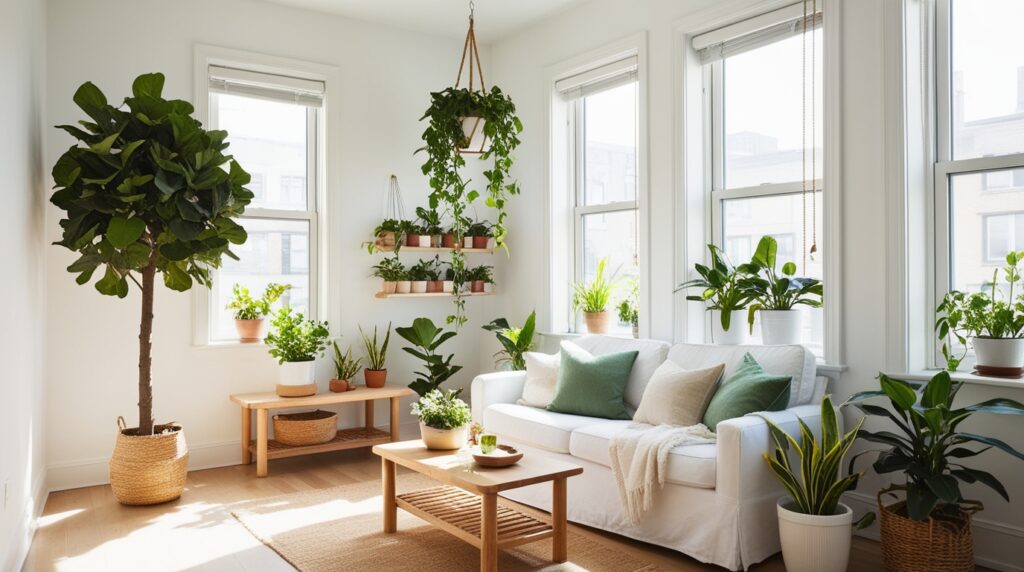
Add Plants for Life and Color
Introduce houseplants to add a touch of nature and improve air quality. Tall plants can draw the eye upward, while hanging plants can add depth without taking up floor space. Choose low-maintenance varieties that thrive in indoor conditions.
Use Natural Materials
Incorporate natural elements like wood, stone, or woven fibers in your furniture and decor. These materials add warmth and texture while creating a connection to the outdoors, which can make the space feel more expansive.
Maximize Views
If your small living room has a view of the outdoors, make the most of it. Keep window treatments minimal and arrange furniture to draw attention to the view, creating a sense of the room extending beyond its physical boundaries.
Technological Integration: Minimalist Tech for Modern Living
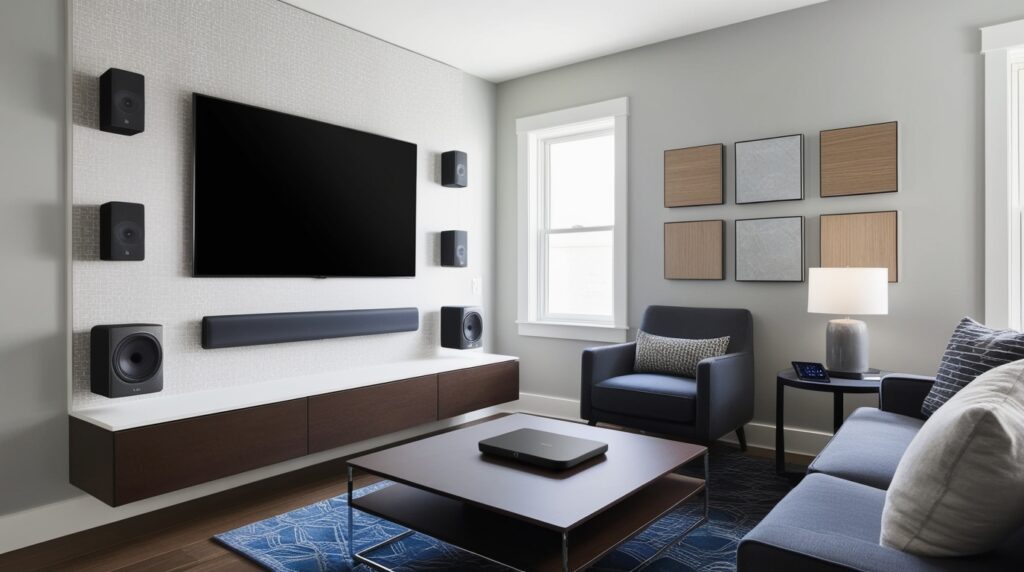
Choose Sleek and Multi-Functional Devices
Opt for slim, wall-mounted TVs or projectors that can be hidden when not in use. Consider smart speakers or sound bars that blend seamlessly with your decor while providing high-quality audio.
Hide Wires and Cables
Keep technology-related clutter to a minimum by using cable management solutions. Hiding wires behind walls or in decorative covers maintains a clean, uncluttered look that contributes to the sense of space.
Implement Smart Home Features
Use smart lighting systems and automated window treatments that can be controlled via smartphone or voice commands. This reduces the need for multiple switches and controls, streamlining the room’s appearance.
Seasonal Adjustments: Adapting Your Space Year-Round

Rotate Decor and Textiles
Change out throw pillows, blankets, and small decor items seasonally to refresh the look of your living room without major overhauls. This keeps the space feeling dynamic and allows you to adapt to changing needs and moods throughout the year.
Adjust Lighting for Seasonal Changes
In darker months, incorporate additional lighting sources to maintain a bright, airy feel. During brighter seasons, use sheer curtains or adjustable blinds to control natural light and prevent the room from feeling overheated or glaring.
Create Flexible Layouts
Design your living room with flexibility in mind. Use lightweight, easy-to-move furniture pieces that allow you to reconfigure the space for different activities or seasons. For example, you might create a cozier arrangement in winter and a more open layout in summer.
Finally
By carefully selecting colors, furniture, and decor while optimizing light, layout, and storage, you can transform a small living room into a space that feels airy, open, and inviting. Whether you’re working with a compact apartment lounge or a cozy home nook, these design strategies ensure that every inch of your living room works harmoniously to create the illusion of more space.
Remember, the key to success is balance. Combine these techniques thoughtfully, always keeping in mind the unique characteristics of your space and your personal style preferences. With creativity and strategic planning, your small living room can become a versatile, stylish haven that feels much larger than its actual dimensions suggest.

